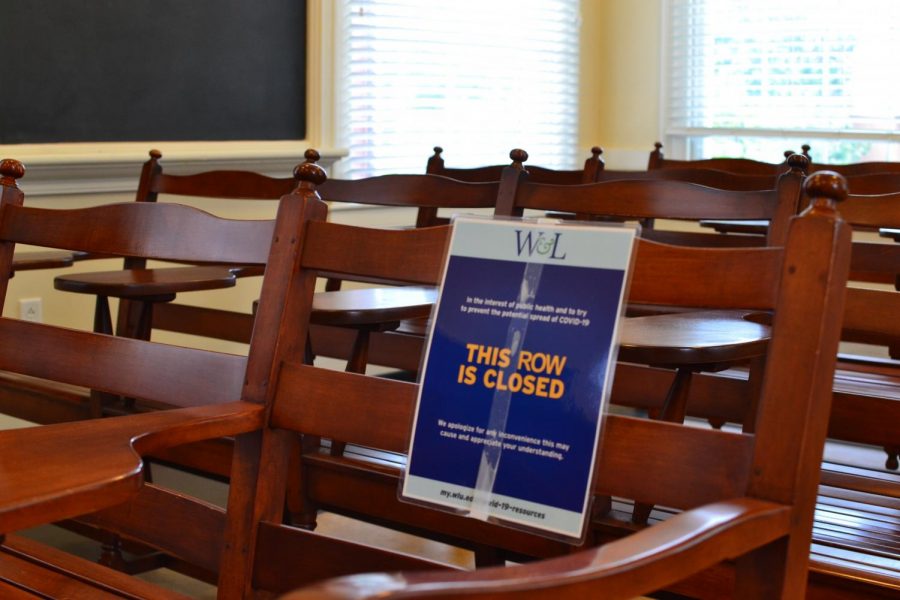Professors strive to “foster community” behind masks or screens
Professor Christopher Jenney said preparing for this semester was “The Great Pivot”
Signs block off chairs in the classrooms of Chavis Hall to facilitate social distancing.
September 22, 2020
The widespread shift to virtual learning has impacted professors as well as students, forcing them to adapt to new educational approaches.
Part of what makes small liberal arts colleges so distinctive is their innate ability to foster relationships between professors and students. This, among many other things, was affected by COVID-19.
Professors reflect on ways to continue fostering the community and relationships that are integral at small liberal arts colleges.
Holly Pickett, an associate professor of english, chose to primarily teach primarily through hybrid classes in order to foster the community and relationships integral to lib- eral arts colleges.
“A class is a community, so cultivating that community is always a top priority for me,” Pickett said. “I tried to pick the format that would give us the best shot at achieving that.”
Professors utilize Canvas discussion boards, the Zoom chat feature, polls, word clouds, Google docs, Jamboards, and Flipgrid videos to communicate effectively.
The faculty at Washington and Lee had what Christopher Jenney, a visiting assistant
professor of cognitive behav- ioral science called “The Great Pivot.”
“I had to learn both the technology and the best practices of online teaching, but Information Technology Services (ITS)
and The Center for Academic Resources and Pedagogical Excellence (CARPE) worked very hard to make the transition easier,” Jenney said.
Although he teaches mostly in person, some professors are taking a virtual or hybrid approach.
“I chose hybrid so that half the class would be meeting mask-to-mask and half would be on Zoom. I thought this would give half the class a chance to participate in discussion without masks, since I and the in-class students would be in masks,” Pickett said,
Like many classes at Washington and Lee, Pickett’s classes rely heavily on discussion.
“I’m a true convert to Canvas Discussion Boards,” she said.
Discussions online, however, are vastly dif- ferent than in-person communication.
“The obvious challenge, I think, is being vir- tual or masked hinders me from noticing the subtle gestures, movements, and inflections of voice that are easier to notice in the class- room and help me to be more responsive to students,” Jenney said.
“This is a liberal arts college and the relationships among the faculty and students are such a fundamental part of the W&L experience.”
The student body may not notice all the faculty work behind the scenes.
“I have had to rethink everything, which in- volved creating new assignments that could transition more easily to virtual learning, as- sembling individual supply kits for students to avoid sharing materials, designing work- stations in the studio to achieve social dis- tancing, and learning new programs in the event we go virtual,” said Pamela H. Simpson Professor of Art Kathleen Olson-Janjic.
She had to adjust her syllabus to accommo- date for the uncertainty.
“The most difficult part of all of this was that faculty had to prepare for all possible scenarios and be ready to switch to complete virtual learning at any moment,” she said. “The uncertainty of it all was at times overwhelming.”
Although her classes are in-person, she still understands the difficulty of online learning.
“Many students have told me they have a harder time processing material and staying engaged when it is presented online. The personal touch of face to face is missing,” she said.
This experience with virtual learning could shape Washington and Lee’s courses in the future, Jenney said.
“We became good at using this technology very quickly. It doesn’t replace the in-person experience, but we certainly should continue to utilize this technology when it is useful,” he said.
While technology might be useful in certain scenarios in the future, professors say that it cannot replace what Washington and Lee does as a small, liberal arts school.
“I am sure this will be an ongoing discussion, but given the importance we put on small classes and individual attention, I find it hard to see W&L going the way of UVA on this. I really don’t think that kind of teaching is as effective,” said Olson-Janjic.
Pickett agrees, saying, “I think we will go back to small, in-person, face-to-face classes as soon as we can. It is part of what makes liberal arts colleges distinctive”.



